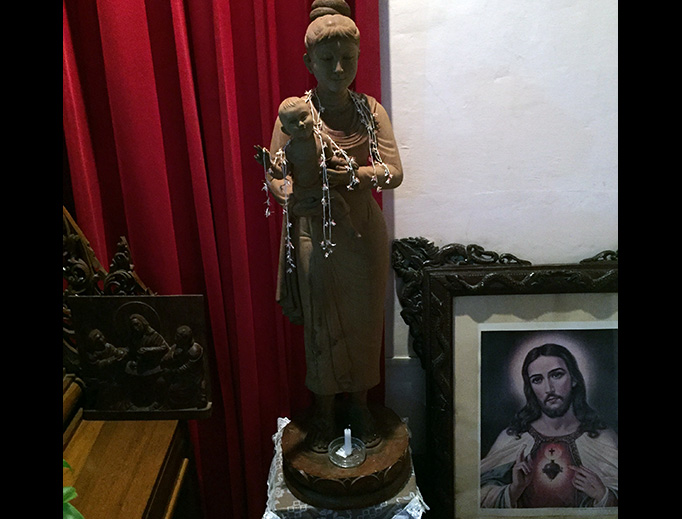The Bishop’s Private Chapel
A visit to the bishop’s chapel at Mandalay’s Sacred Heart Cathedral

There I was enjoying a magnificent spicy Burmese meal at the rectory of Mandalay’s Sacred Heart Cathedral when, all of a sudden, the priests at the other table asked if I wanted to see the chapels. They specifically said chapels―in the plural.
Most, if not all, Catholic clergy houses and houses of formation have private chapels where the good fathers can simply get away from all of the hubbub and folderol of everyday parish life and reconnect with God, but I’ve never heard of a rectory with more than one chapel.
“What do you mean chapels?” I asked. “You have more than one here?”
“Oh, yes!” came back the reply. “The bishop has his own private chapel. It’s really beautiful.”
To say my interest was merely piqued would be a gross understatement.
My head spun with visions of the chapels of Versailles or perhaps Sainte-Chapelle itself. In my fevered imagination, the bishop’s chapel came with its own actual choir, lofty, vaulted ceilings and a pulpit large enough in which to swing a cat. Perhaps a great big piece of the True Cross. Perhaps a holy water fountain with a continual supply of actual holy water from the River Jordan. And everything was mahogany and teak… gilded mahogany and teak. The sublimest height of ecclesiastical architecture awaited me behind unlocked doors in the bishop’s private residence.
When I heard of its existence, I couldn’t resist. And, as they say, I can resist anything but temptation.
As we stealthily made our way to the bishop’s chapel, I kept looking behind me thinking, “Surely this is a sin!” And I can assure you that as I embarked upon the Road to Perdition once again, I could clearly hear the theme music from the Mission: Impossible soundtrack.
Frankly, as a foreigner and a journalist, I probably could get away with more than a local. I can claim plausible deniability if necessary as I’m unfamiliar with the local language and customs. “What?! You mean lay people aren’t warmly invited into the bishop’s private chapel? Oh! How quaint! In the rest of Latin Christendom, the ordinary himself would be at the door of his chapel handing out brochures!”
Frankly, if the bishop caught me, I’d be more than happy to throw my two clerical co-conspirators under the figurative ecclesiastical bus in a heartbeat for “forcing” me to intrude upon His Grace’s private chapel.
I just hoped it wouldn’t come to that but I have a strong sense of self-preservation that borders on narcissism so it’s hard to know what I’d do if the bishop caught us unawares.
My priest provocateurs opened the doors to the chapel. I took a deep breath and stepped boldly where no layman had ever gone before and where this Angel(o) didn’t fear to tread.
Contrary to what I had imagined in terms of excess and splendor, the chapel was rather spartan.
There was enough prie-dieux in the small sacred space for a gaggle of bishops, if “gaggle” was indeed the collective noun for bishops. (In actuality, a group of bishops is referred to as a psalter of bishops, which seems oddly correct.)
The altar was small and lighting was dim. However, the one standout artistic treasure was a magnificent, hand-carved, teak reredos. Every Catholic church I visited throughout Burma used the same decoration behind the high altar, which I found both charming and delightful. I found myself mesmerized by the one before me.
And throughout my time gazing at this artistic masterpiece, I had a dread feeling that this is where God calls the local ordinary to the carpet if and when necessary.
Bishops always have had my great respect and figure highly in my prayers―I can only imagine that God will be tougher on them than upon the rest of us. They are, after all, entrusted with great spiritual and moral authority over the rest of us. And there’s a perfectly good reason why they are responsible for us and why they are called our shepherds. Keep in mind the bishop’s crosier has a flat end and a pointy end. The flat end is to chide us along on the Path to Righteousness. The pointy end is for when he really means business.
And, frankly, I’d hate to have to be on the wrong business end of that symbol of authority.













